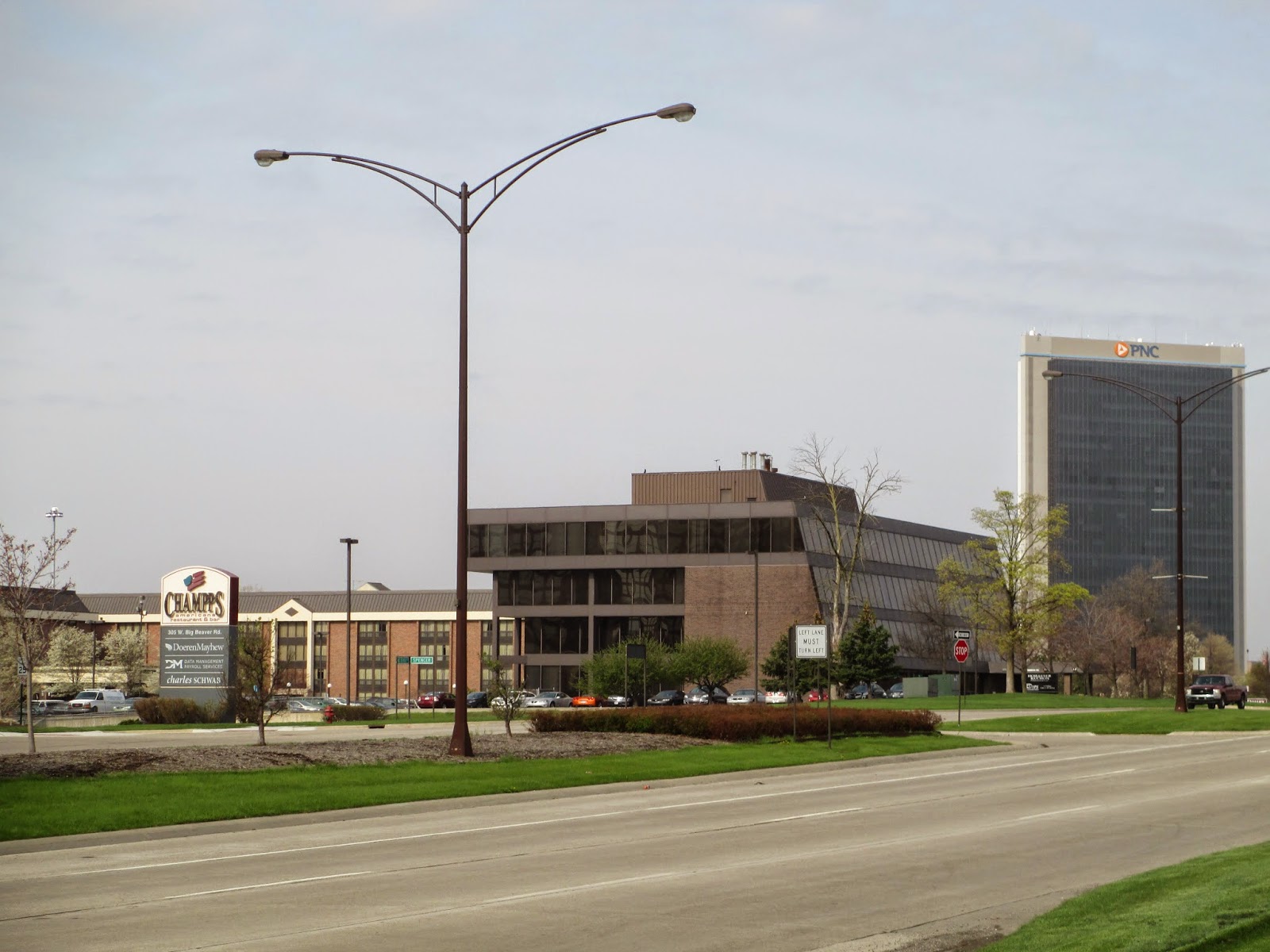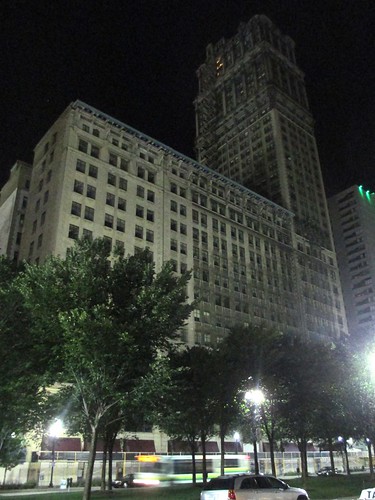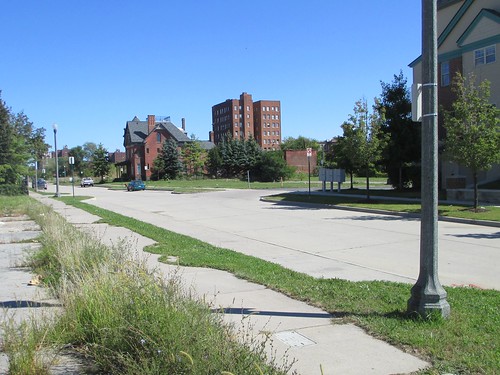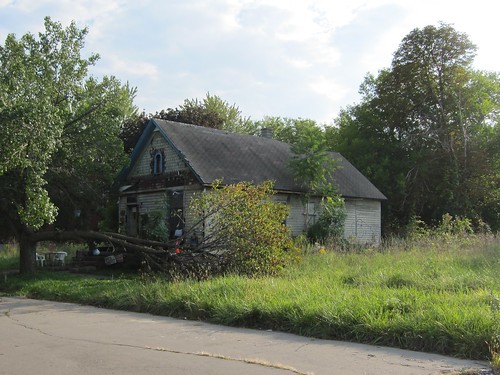As the bus carrying me and a group of other journalists and
analysts pulled up to the Troy Marriott hotel near Detroit last Monday night, I started doing
what any self-respecting professional traveller would have done – looking for
enticing dinner options. In an unpromising area, the only alternative I could
see to the hotel’s own restaurant was a sports bar – imaginatively named “Champps”
– just across Big Beaver Road .
While it seemed unlikely to be a hidden gourmand treat, it seemed more enticing
once I’d seen the hotel restaurant’s prices and depressing beer range.
 |
| Champps: enticing - sort-of - amid limited circumstances |
Yet I ended up all three nights of my stay trooping
down to the hotel’s restaurant and ordering mediocre, absurdly-priced food ($29
for a pork porterhouse cooked so that it’s almost impossible to cut, anyone?)
rather than venturing out. Closer examination revealed that, while
Champps was close geographically, without a car it might as well be in
the next state. There was no pedestrian crossing to take me across Big Beaver Road ’s
six lanes of high-speed traffic. Big Beaver
Road did have sidewalks, unlike some suburban American streets (or stroads, as such highway streets are sometimes known). But they were cut off from the road and appeared built on the
principle that pedestrians walk only in straight lines. Champps didn’t look
worth the risk of a dash across the traffic.
My near-yet-far experience with dinner options opened my
eyes to how comprehensively some suburban areas of the US – and, to a
lesser extent, some European countries too – are built around transport by car.
I fully understood for the first time how oppressive the sheer lack of choice
in such areas is. It made me appreciate how, whatever my gripes about London in the past and New York at present, I’ve at least lived in
places that offer some transport freedom of choice.
 |
| Big Beaver Road: would you risk crossing? |
Of course, many Americans would say I’m showing my East
Coast elitist or European thought patterns by viewing such conditions as
problematic. Suburbs are popular, some transport thinkers tell me, because
Americans just plain want to live in single-family houses with a big area of
land around them. It’s mere snobbery for those of us who live in big, cramped
cities to expect those who prefer the lower-density suburbs to adapt to living
lives more like our own. There are plenty of similar trends among pro-car
thinkers in the UK .
But my experience last Wednesday – when I went on a coach
trip with other reporters and analysts from Troy
to Toledo , Ohio Detroit before he
could drive at any reasonable speed on the way to Toledo .
Our hosts felt under stress throughout the day – and
curtailed one of the most interesting parts of our visit in Toledo – because of the problems of maintaining
our visit schedules on roads that made travel times unpredictable. I,
meanwhile, sat in something like awe of the quantity of traffic disruption
related to traffic heading into central Detroit .
“What would this be like if Detroit
were still a healthy city?” I asked myself, staring at the ranks of red rear
lights on the Interstate. The vehicles were heading for a city centre where
many lots remain vacant and whose population is only a third of its more than 2m peak. It wasn’t the first time I’d experienced big, severe traffic jams in Detroit ’s morning rush
hour.
The problems I witnessed are only an extreme example of the
pressures that any city with low-density, far-flung suburbs with poor public
transport and a dense inner city will tend to face. I had a taste of how even
high-density New York
struggles with such flows one morning in early April when a truck crashed on
the Brooklyn-Queens expressway and closed both carriageways. I was suddenly
sharing our neighbourhood streets with the vast lines of slow-moving car
commuter traffic that outer parts of Brooklyn, Queens, Staten Island and the Long
Island suburbs generate. I normally see such traffic only from a distance,
and generally only creeping towards its destination.
There’s a fundamental geographical problem. Distances in
low-density suburbs are vast and forbidding for walking or cycling. But it’s
hard to provide public transport for a place where the customers are all so far
apart. When all those suburbanites jump into their cars to head for a city, the
cars can’t all fit.
The root of the problem is partly social. I was watching in
the rainy Detroit rush hour partly a distant reverberation from the shattering
explosion of Detroit’s 1967 race riots, which wrecked vast tracts of the city
and sent many white people – and quite a few blacks too – scurrying for the
perceived safety of places like Troy. It’s an essential part of the bargain of
living in a big city like New York – or London – that one puts up with – maybe
even celebrates – living cheek-by-jowl with people of different racial or economic backgrounds or very different outlooks on life. Race riots, second world war bombing or, in New York City ’s
case, the deliberate policies of Robert Moses have broken that contract down in
the cities now facing the worst problems.
 |
| Downtown Detroit: hassly but hopeful |
I’ve consistently voted with my feet on this issue. In my
adult life, I’ve lived in dense, inner-urban areas of Edinburgh ,
London , Budapest
and New York ,
prioritising convenience of walking, cycling and public transport over avoiding
the hassles of inner-city life. Even when I visit the Detroit
area or Fort Worth , Texas Detroit .
But I still prefer the inner city’s challenges to the soullessness of the outer
suburbs.
None of which would matter, conceivably, if the suburbs were
actually satisfying suburbanites. But, even with the continued pull of better
schools and leafy tranquillity, there’s mounting evidence that leafy places like
Troy are losing out to asphalt-covered,
brick-built places like downtown Detroit .
New York City holds more people than it’s ever held, while suburban Long Island's population has grown more slowly in recent years than most of the rest of the region. It’s London – not the suburbs of
Hertfordshire or Surrey – that’s looking to
cater for millions of new residents over the next few years. Places whose
residents don’t need cars are becoming more attractive.
I won’t pretend, of course, that inner-city Detroit – currently bankrupt, long corrupt
and full of houses being reclaimed by the prairie – is a paragon that other
cities should follow. But the growing activity in its downtown and the
sprouting of cycle lanes and the sight of the occasional cyclist give me some
optimism. It’s easier for me to see why the attractions of places like clean,
leafy Troy – where the only walking most people do is across the parking lot –
are starting to pale. It’s no surprise to me that the US ’s most successful suburbs – the DC suburbs in
northern Virginia
– are working hard at putting in bike lanes, improving public transport and
making people who want a congestion-free car commute pay for the privilege. It
would be heartening to see suburbs elsewhere – like Troy
or the most traffic-clogged bits of London ’s
commuter belt – following suit.
 |
| 1st Avenue: sure, motorists don't know how to drive there politely. But Big Beaver Road it ain't. |
For me, meanwhile, the motor vehicle-dependence was at least
temporary. I had a long wait on my return to LaGuardia Airport
 |
| The Queensboro Bridge: there are subways below, cars, buses and bikes on the surface and even a cable car above. |
It wasn’t, I admit, a complete joy interacting with New York City drivers as I headed north through Brooklyn
towards Queens . My first ride up
the new First Avenue bike lane on the Upper East Side was marred by the
discovery that drivers are as reluctant to yield to cyclists there as elsewhere in the city. Even on my ride north and round the top of Central
Park , I found myself sharing the roadway with cars whose drivers
viewed the park’s speed limit as optional.
But, after spending most of the week by a road that was
impossible to cross, I found it hard to feel truly angry. The best bits of the
journey – the well-designed bike lanes up Kent Avenue, the bike and pedestrian
lane over the Queensboro Bridge and the ride south by the Hudson – made me feel
quite the opposite. What a privilege it was, I realised, to live in a city where
few need feel wedded to their cars and growing numbers choose to get about by
bike. As I embark on a new week of hustling for space and priority with the
city’s drivers, I’ll do my very best to retain that feeling.



I especially love this post because it's kind of a mirror-image experience to what I felt when I visited my sister in Brooklyn last summer. I was blown away by the number of alternatives to getting around by car that exist there, compared to Texas - Austin is at least pretty bike-friendly (including, I suspect, kinder and more patient drivers than you tend to experience in NYC) - but that's about it; the city's layout, most growth having taken place during the height of car culture, makes effective public transit a huge challenge. The ethnic and cultural diversity was amazing. And the population as a whole looked quite a bit more physically fit. There is a lot of walking between subway stations - which, for someone not accustomed to them, are like magic - you can descend into the ground and come out anywhere else you want!
ReplyDeleteI see a lot of local resistance to expanding transportation alternatives. I think there's a kernel of fear in it; it isn't just about not wanting to spend public money on infrastructure that (it's perceived that) only a few people will use; I really think people sense that car culture isn't sustainable and it bothers them on a very deep level. I'm not sure how else to explain the level of anger I see attached to transportation issues. But after my trip last year (my first to NYC) I wish a lot more people would go and see how wonderful transportation alternatives can be!
Beth,
DeleteThanks for your kind words - and I'm glad you enjoyed visiting our borough. We're quietly pleased with it ourselves - but you probably gathered that. I talked to the driver who took me to the airport on the way home and he had a similar story. He went to visit friends in Chicago from time to time and they sometimes visited him near Detroit. In Chicago, he was amazed how seldom it was necessary to use a car. When visiting the Detroit area, his friends found the need for a car frustrating.
You're absolutely correct about the apparent magic of subways. It's a big point with me not only because my father devoted his life to working on and improving mass transit systems but because the subways in NYC held up remarkably well during this past winter (a point I documented here: http://invisiblevisibleman.blogspot.com/2014/02/the-c-train-my-childhood-and-why-subway.html). You're also correct about physical fitness. There was no missing that there were far more severely overweight people in Michigan than in New York. I'm sure transport plays a big part in that.
As for why people get so angry about spending on alternatives to the car, I'm not sure why it raises hackles quite so much. But I think there are two main things. Motorists feel they're paying a lot to drive (even though they're nowhere near covering the costs of providing roads in most states). They also feel, I think, that mass transit systems represent the gummint's interfering in their inalienable right to drive wherever and whenever they want, without all the other people who are exercising the same right getting in the way.
All the best,
Invisible.
Robert wrote:
ReplyDelete"Suburbs are popular, some transport thinkers tell me, because Americans just plain want to live in single-family houses with a big area of land around them."
Kevin's comment: Which is why housing in Manhattan is so cheap. Nobody wants to live there. :)
On a more serious note, unlike most countries in the world, Americans are deprived of the opportunity to live in car-free urban areas.
One does not even have to go to Europe or Japan. Amtrak will take one from New York to Toronto, home of North America's largest urban car-free zone. Where the high demand to live there can be seen whenever a lottery is conducted for spots on the 15-year-long waiting list to buy a home in the car-free zone. For every spot on the wait list, over 10 people lay out $125 for a chance to win it.
In Europe and Japan, compare the real estate prices in urban car-free zones with prices outside the zone. For example, in Venice vs. the adjoining mainland. People vote with their wallets for car-free living whenever they are offered a choice.
Too bad that in the USA there is no choice.
Kevin,
DeleteThanks for your comment. It's true that supply and demand suggests people want to live in less car-dependent places - though there's a fair demand to live in, say, the DC suburbs too. The DC suburbs are fairly car-dependent, even if they're trying to address the issue.
It's hard to foresee immediately anywhere in the US going for the car-free idea, though I know you're keen to see one for all of Manhattan. I guess my feeling is it would be nice to see far more car-tamed areas in the US - places where cars are prevented from ruining all urban space. More of those places are a possibility - although where one would start with Troy I don't know.
All the best,
Invisible.
the D.C. suburbs are very different. Arlington is right across the river from D.C and closer to downtown D.C. than much the the city. Arlington, unlike D.C. doesn't have a height limit so its full of office towers. It looks more like a central city in many ways than downtown Detroit. The suburbs of D.C. have car dependent places but also many pockets of transit oriented development. For example when I worked in silver spring, I needed a car for local errands, but could walk to the subway to go downtown for dinner.
Deleteits too bad you didn't stay in a better area of Detroit or better suburb like Birmingham or Royal Oak.
Brandon,
DeleteThanks for your comment. As I say in the piece, I try to stay in downtown Detroit when visiting the area. Unfortunately, on this occasion I was in the area to report on an event at Chrysler's headquarters in Auburn Hills. Given their distance from downtown, it made more sense to stay in Troy.
All the best,
Invisible.